Greenhouse Gas Emission Scenarios and Vehicle Engine Performance in a Main Urban Road in Northwestern Mexico
Abstract
Featured Application
Abstract
1. Introduction
2. Materials and Methods
2.1. Selection of Main Urban Road
- Being a primary urban road;
- High vehicular volume in relation to other roads;
- Presenting a variability in terms of vehicle classification;
- Presenting connectivity with other primary and secondary urban roads, as well as with a variety of urban land uses;
- Being susceptible to infrastructure and operation changes.
2.2. Information Gathering and Analysis
2.3. Transport Emissions Model
- Considered criteria:
- The model worked only for GHG vehicle emissions, (as proposed in the methodology);
- The emission factors proposed by the IPCC were used for road transport models;
- Within the emissions, CO2, CH4 y N2O are already quantified and are presented as CO2e, considering their respective global warming potentials and the respective types of vehicles;
- No adjustments were made to the uncertainties of GHG emission factors (EF) stipulated by the IPCC;
- Regarding the field information used to calculate the activity data (DA), a statistical error of 1% was considered in such a way that the p-value calculation was smaller than that error.
- Not considered criteria:
- The model does not consider other polluting sources, besides the GHG specified by the IPCC methodology, for example, criteria pollutants for smog-control measurements, which were carried out in closed enviroments.
2.4. Emissions Model Simulation
2.5. Projection Scenario and Simulation Planning of Urban Road Imrpovement Actions
- Road infrastructure improvements (lane adequacy and smart traffic lights);
- Urban road recarpeting;
- Continuous flow (no crossings with other arterial roads).
3. Results and Discussion
3.1. Vehicle Volume Measurement (VVM)
3.2. Travels and Equivalent CO2 Emissions in Each VVM Point
3.3. Projection of Equivalent CO2 Emissions
4. Conclusions
Author Contributions
Funding
Institutional Review Board Statement
Informed Consent Statement
Data Availability Statement
Acknowledgments
Conflicts of Interest
References
- Klemm, C.; Wiese, F. Indicators for the optimization of sustainable urban energy systems based on energy system modeling. Energy Sustain. Soc. 2022, 12, 3. [Google Scholar] [CrossRef]
- Sajede, A.; Mohsen, S.; Fahime, M.; Borna, A. Factors affecting the emission of pollutants in different types of transportation. Energy Rep. 2022, 8, 2508–2529. [Google Scholar] [CrossRef]
- Menendez, M.; Ambühl, L. Implementing Design and Operational Measures for Sustainable Mobility: Lessons from Zurich. Sustainability 2022, 14, 625. [Google Scholar] [CrossRef]
- Guo, Y.; Ma, Z.; Ren, B.; Zhao, B.; Liu, P.; Zhang, J. Effects of Humic Acid Added to Controlled-Release Fertilizer on Summer Maize Yield, Nitrogen Use Efficiency and Greenhouse Gas Emission. Agriculture 2022, 12, 448. [Google Scholar] [CrossRef]
- Fang, D.; Mueller, C. Mortise-and-tenon joinery for modern timber construction: Quantifying the embodied carbon of an alternative structural connection. Arch. Struct. Constr. 2021, 1–14. [Google Scholar] [CrossRef]
- Górka, M.; Bezyk, Y.; Sówka, I. Assessment of GHG Interactions in the Vicinity of the Municipal Waste Landfill Site—Case Study. Energies 2021, 14, 8259. [Google Scholar] [CrossRef]
- Stubenrauch, J.; Garske, B.; Ekardt, F.; Hagemann, K. European Forest Governance: Status Quo and Optimizing Options with Regard to the Paris Climate Target. Sustainability 2022, 14, 4365. [Google Scholar] [CrossRef]
- IEA (International Energy Agency). Data and Statistics: “CO2 Emissions by Sector, World 1990–2019”. Available online: https://www.iea.org/data-and-statistics/data-browser?country=WORLD&fuel=CO2%20emissions&indicator=CO2BySector (accessed on 10 April 2022).
- ProAire. Programa Para Mejorar la Calidad del Aire en Mexicali 2011–2020. Available online: https://www.gob.mx/cms/uploads/attachment/file/69289/12_ProAire_Mexicali.pdf (accessed on 22 February 2022).
- Zhang, H.; Mu, J.E.; McCarl, B.A.; Yu, J. The impact of climate change on global energy use. Mitig. Adapt. Strat. Glob. Chang. 2022, 27, 9. [Google Scholar] [CrossRef]
- Garrido, P. CO2 Emissions arising from the displacement of the population in private transport mode in Gran Santiago. Rev. Geogr. Espac. 2013, 3, 69–86. [Google Scholar] [CrossRef]
- Obaid, M.; Torok, A. Macroscopic Traffic Simulation of Autonomous Vehicle Effects. Vehicles 2021, 3, 187–196. [Google Scholar] [CrossRef]
- Ajay, P.; Nagaraj, B.; Pillai, B.M.; Suthakorn, J.; Bradha, M. Intelligent ecofriendly transport management system based on IoT in urban areas. Environ. Dev. Sustain. 2022, 24, 5. [Google Scholar] [CrossRef]
- Moussa, R.R. Reducing carbon emissions in Egyptian roads through improving the streets quality. Environ. Dev. Sustain. 2022, 24, 5. [Google Scholar] [CrossRef]
- Shokoohyar, S.; Jafari Gorizi, A.; Ghomi, V.; Liang, W.; Kim, H.J. Sustainable Transportation in Practice: A Systematic Quantitative Review of Case Studies. Sustainability 2022, 14, 2617. [Google Scholar] [CrossRef]
- Zhang, L.; Kou, C.; Zheng, J.; Li, Y. Decoupling Analysis of CO2 Emissions in Transportation Sector from Economic Growth during 1995–2015 for Six Cities in Hebei, China. Sustainability 2018, 10, 4149. [Google Scholar] [CrossRef]
- Sun, L.; Song, R. Improving Efficiency in Congested Traffic Networks: Pareto-Improving Reservations through Agent-Based Timetabling. Sustainability 2022, 14, 2211. [Google Scholar] [CrossRef]
- Velepucho-Sanchez, J.M.; Sabando-Piguabe, L.F. Emisiones de gases contaminantes en vehículos livianos a gasolina. Rev. Cient. INGENIAR: Ing. Tecnol. E Investig. 2021, 4, 78–95. [Google Scholar] [CrossRef]
- INEN. Environmental Management. Air. Motor Vehicles. Emissions Permitted Levels Produced by Road Movable Sources Using Gasoline. Servicio Ecuatoriano de Normalización. NTE INEN 2204. Segunda revision 2017-01. Quito, Ecuador. Available online: https://www.normalizacion.gob.ec/buzon/normas/nte_inen_2204-2.pdf (accessed on 30 March 2022).
- Gebisa, A.; Gebresenbet, G.; Gopal, R.; Nallamothu, R.B. Driving Cycles for Estimating Vehicle Emission Levels and Energy Consumption. Futur. Transp. 2021, 1, 615–638. [Google Scholar] [CrossRef]
- Solis, J.; Sheinbaum, C. Consumo de energía y emisiones de CO2 del autotransporte en México y escenarios de mitigación. Rev. Int. Contam. Ambient 2016, 32, 7–23. [Google Scholar]
- Heidari, E.; Bikdeli, S.; Mansouri Daneshvar, M.R. A dynamic model for CO2 emissions induced by urban transportation during 2005–2030, a case study of Mashhad, Iran. Environ. Dev. Sustain. 2022, 1–20. [Google Scholar] [CrossRef]
- Pichlmaier, S.; Kult, M.; Wagner, U. Extension of Energy and Transport Scenario Modelling to Include a Life Cycle Perspective. Futur. Transp. 2021, 1, 188–201. [Google Scholar] [CrossRef]
- Mazza, S.; Aiello, D.; Macario, A.; De Luca, P. Vehicular Emission: Estimate of Air Pollutants to Guide Local Political Choices. A Case Study. Environments 2020, 7, 37. [Google Scholar] [CrossRef]
- Paulino, F.; Pina, A.; Baptista, P. Evaluation of Alternatives for the Passenger Road Transport Sector in Europe: A Life-Cycle Assessment Approach. Environments 2018, 5, 21. [Google Scholar] [CrossRef]
- Salini, R.; Lenngren, C.A.; Bassi, L.; Baesso, D.P. Greenhouse Gas Assessment and Compensation on Brazilian Low Volume Rural Roads Using CarbonROAD—The Santa Rosa de Lima Case. Environments 2015, 2, 489–499. [Google Scholar] [CrossRef]
- Christian, A.; Kristian, L.; Björn, A. Global energy scenarios meeting stringent CO2 constraints—Cost-effective fuel choices in the transportation sector. Energy Policy 2003, 31, 961–976. [Google Scholar] [CrossRef]
- García Cueto, O.R.; Santillán Soto, N.; Quintero Núñez, M.; Ojeda Benítez, S.; Velázquez Limón, N. Extreme temperature scenarios in Mexicali, Mexico under climate change conditions. Atmósfera 2013, 26, 509–520. [Google Scholar] [CrossRef]
- INEGI Instituto Nacional de Estadística y Geografía. Censo de Población Y Vivienda 2020. Available online: https://cuentame.inegi.org.mx/monografias/informacion/bc/poblacion/ (accessed on 17 March 2022).
- Universidad Autónoma de Baja California (UABC). Un Espacio Urbano en la Estrategia Internacional; Atlas de Mexicali; Universidad Autónoma de Baja California (UABC): Mexicali, Mexico, 2001; pp. 1–37. ISBN 970-9051-19-9. [Google Scholar]
- PMVT (Plan Maestro de Vilidad y Transorte), Sistema Municipal de Transporte de Mexicali, B.C.; XX Ayuntamiento de Mexicali: Mexicali, Mexico, 2011; Available online: https://www.mexicali.gob.mx/sitioimip/fotos/5b26e9e0639f.pdf (accessed on 18 June 2022).
- SEMARNAT-INE. Tercer Almanaque de Datos Y Tendencias de la Calidad Del Aire en Nueve Ciudades Mexicanas. 2007. Available online: https://sinaica.inecc.gob.mx/archivo/informes/3erAlmanaque.pdf (accessed on 24 March 2022).
- Amézquita-López, J.; Valdés-Atencio, J.; Angulo-García, D. Understanding Traffic Congestion via Network Analysis, Agent Modeling, and the Trajectory of Urban Expansion: A Coastal City Case. Infrastructures 2021, 6, 85. [Google Scholar] [CrossRef]
- Casa Mayers (Centro de servicios distribuidor). Categoría Y Características de Cuenta Unidades Como Instrumento de Medición. Available online: https://www.casamyers.com.mx/view/cat1:INSTRUMENTOS%20DE%20MEDICIÓN/cat2:CONTADORES/cat3:CUENTA%20BULTOS (accessed on 24 February 2022).
- IPCC. Guidelines for National Greenhouse gas Inventories. Volume 2 Energy. 2014. Available online: https://www.ipcc-nggip.iges.or.jp/public/2006gl/spanish/index.html (accessed on 10 February 2022).
- PEACC. Proyecto Para Desarrollar El Programa de Cambio Climático en El Estado de Baja California; Estudio: “Sector Transporte”; PEACC: Mexicali, BC, USA, 2013; pp. 85–97. Available online: https://biblioteca.semarnat.gob.mx/janium/Documentos/Ciga/Libros2013/CD001769.pdf (accessed on 15 March 2021).
- Isee Systems. Technical Documentation for the Ithink & STELLA Software. 2007. Available online: https://www.iseesystems.com/store/products/stella-architect.aspx (accessed on 18 March 2022).
- Rojas, D. Simulación de la Aplicación Del Tratamiento Mecánico Biológico a Los Residuos Urbanos. Master’s Thesis, Facultad de Ingeniería, Universidad Nacional de La Pampa, La Pampa, Argentina, 2010. Available online: http://www.biblioteca.unlpam.edu.ar/rdata/tesis/i_rojsim000.pdf (accessed on 13 August 2022).
- Diaz, C.; Sosa, M. Movilidad Sostenible: Medir El Kilometraje Recorrido Por Vehículos Mejora la Planeación Y Gestión Urbana. Banco Interamericano de Desarrollo (BID), Transporte. Available online: https://blogs.iadb.org/transporte/es/movilidad-sostenible-medir-el-kilometraje-recorrido-por-vehiculos-mejora-la-planeacion-y-gestion-urbana/ (accessed on 28 March 2022).
- Pérez Cruz, J.R.; Lakouari, N.; Pérez Sansalvador, J.C.; Zapotecatl López, J.L. Effect of Interactions between Vehicles and Mid-Block Crosswalks on Traffic Flow and CO2 Emission. Appl. Sci. 2021, 11, 11794. [Google Scholar] [CrossRef]
- Chatzikomis, C.I.; Spentzas, K.N.; Mamalis, A.G. Environmental and economic effects of widespread introduction of electric vehicles in Greece. Eur. Transp. Res. 2014, 6, 365–376. [Google Scholar] [CrossRef]
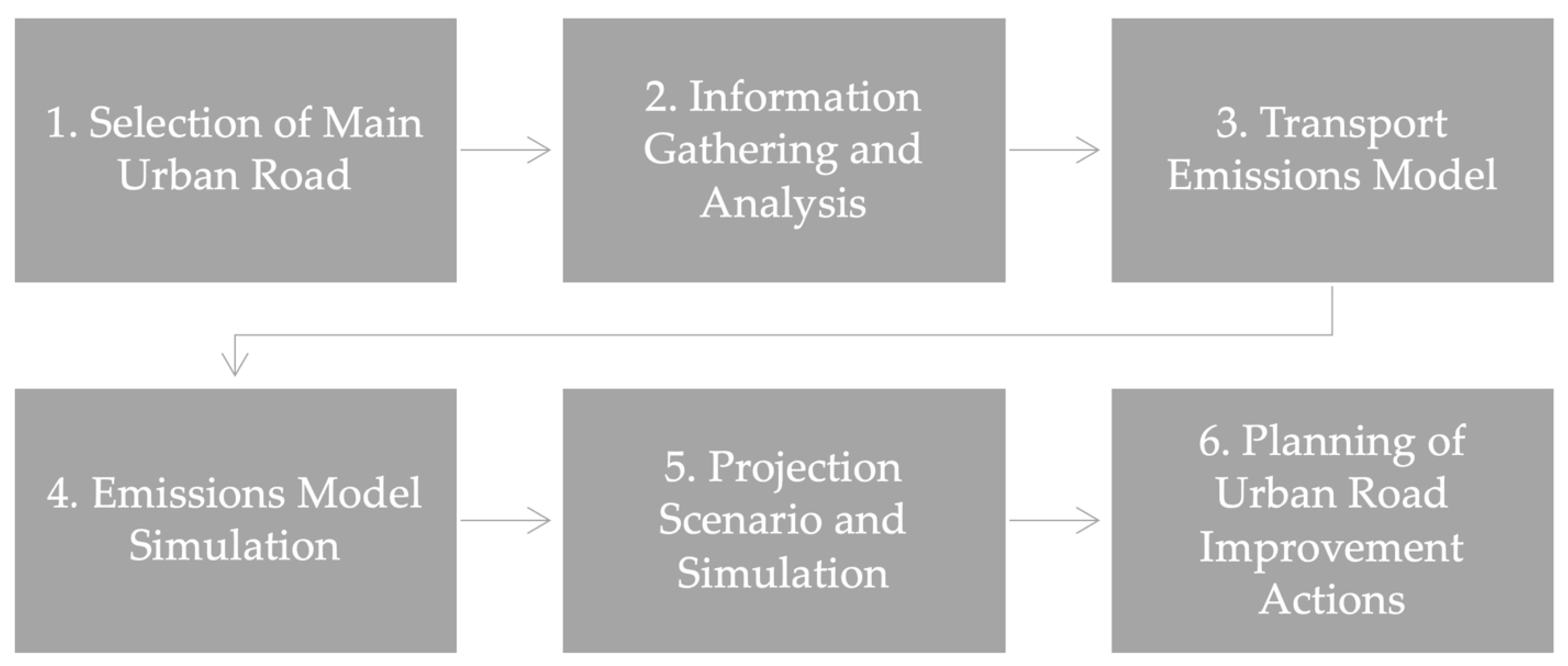
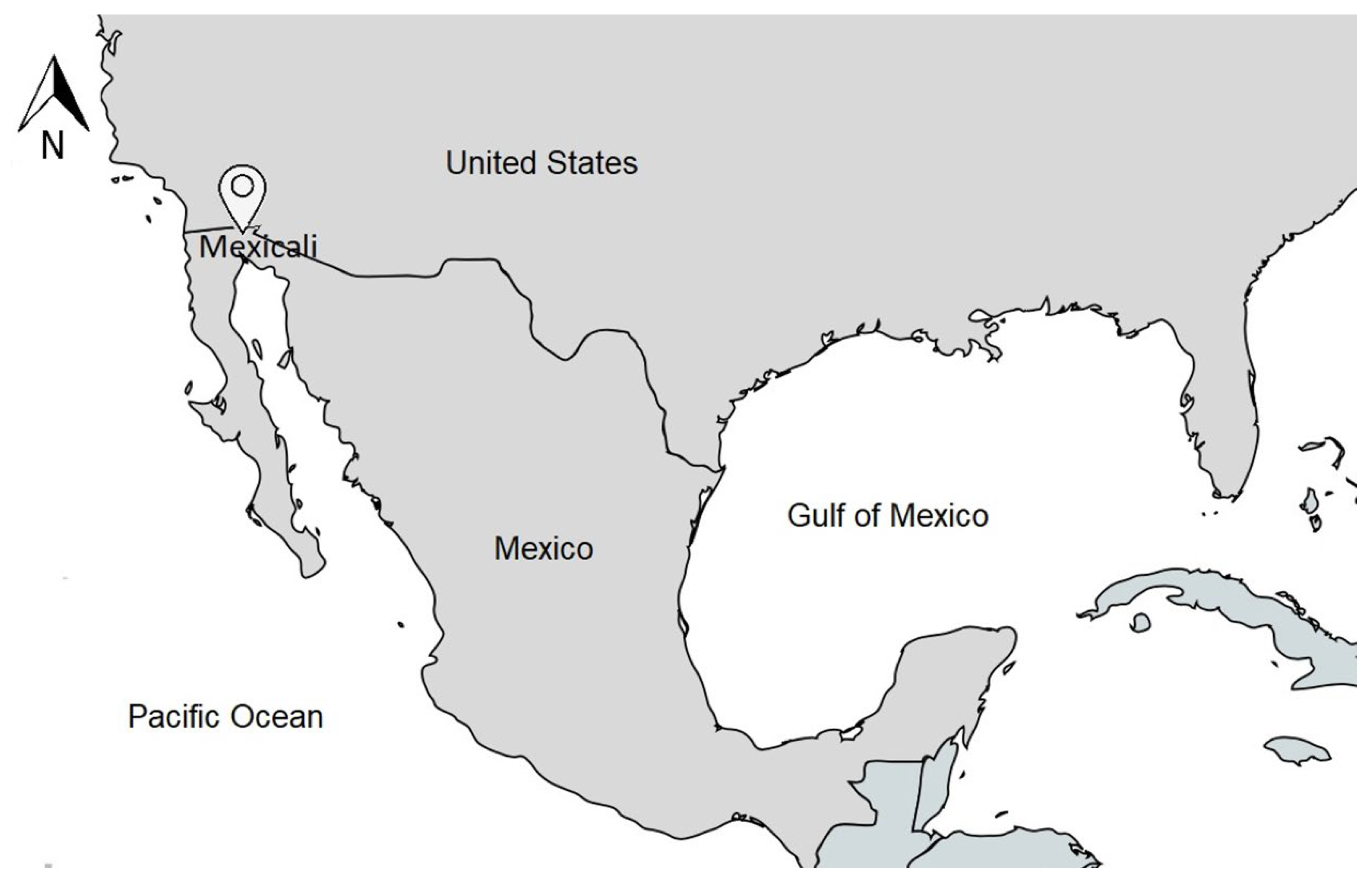
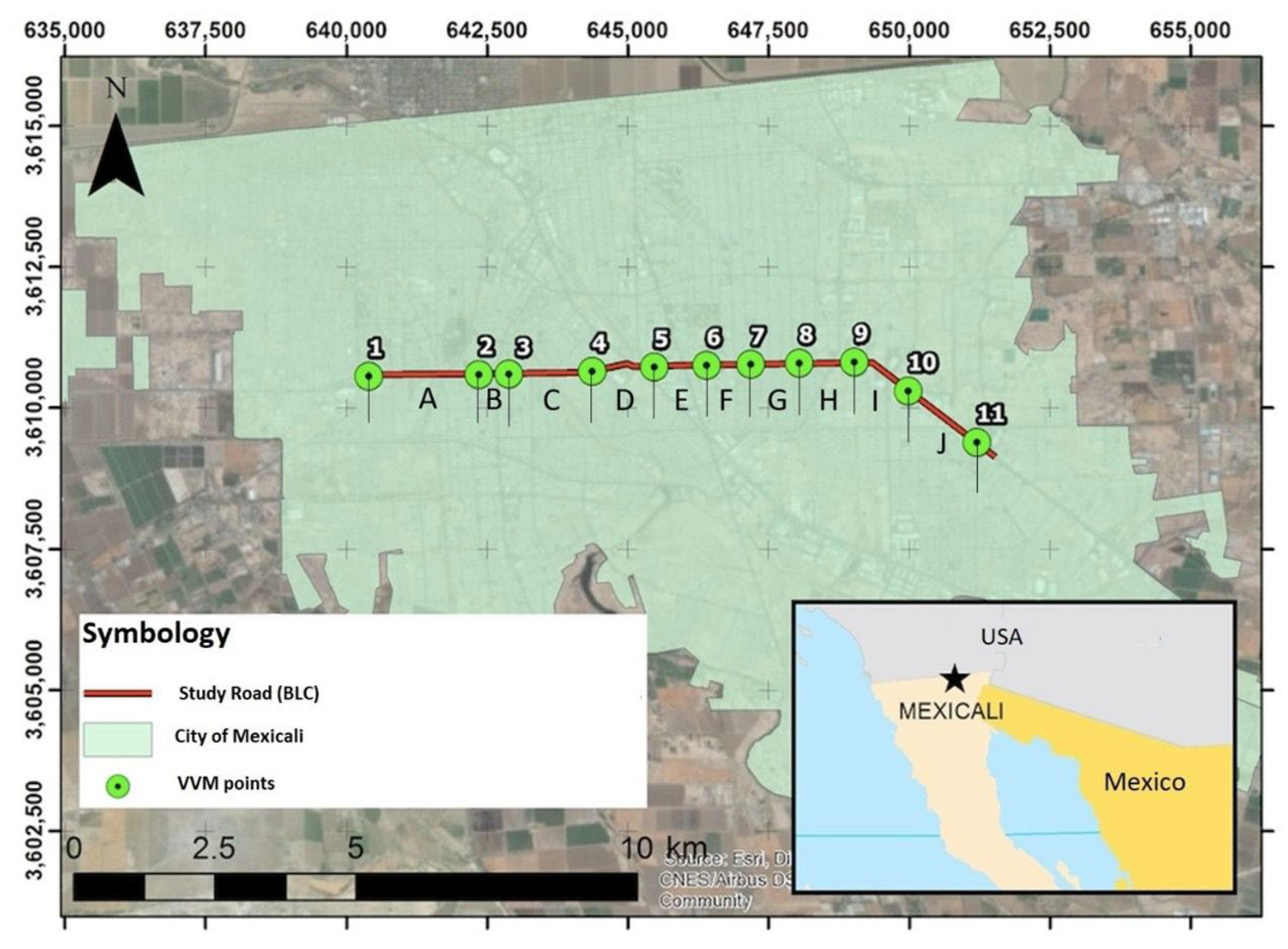
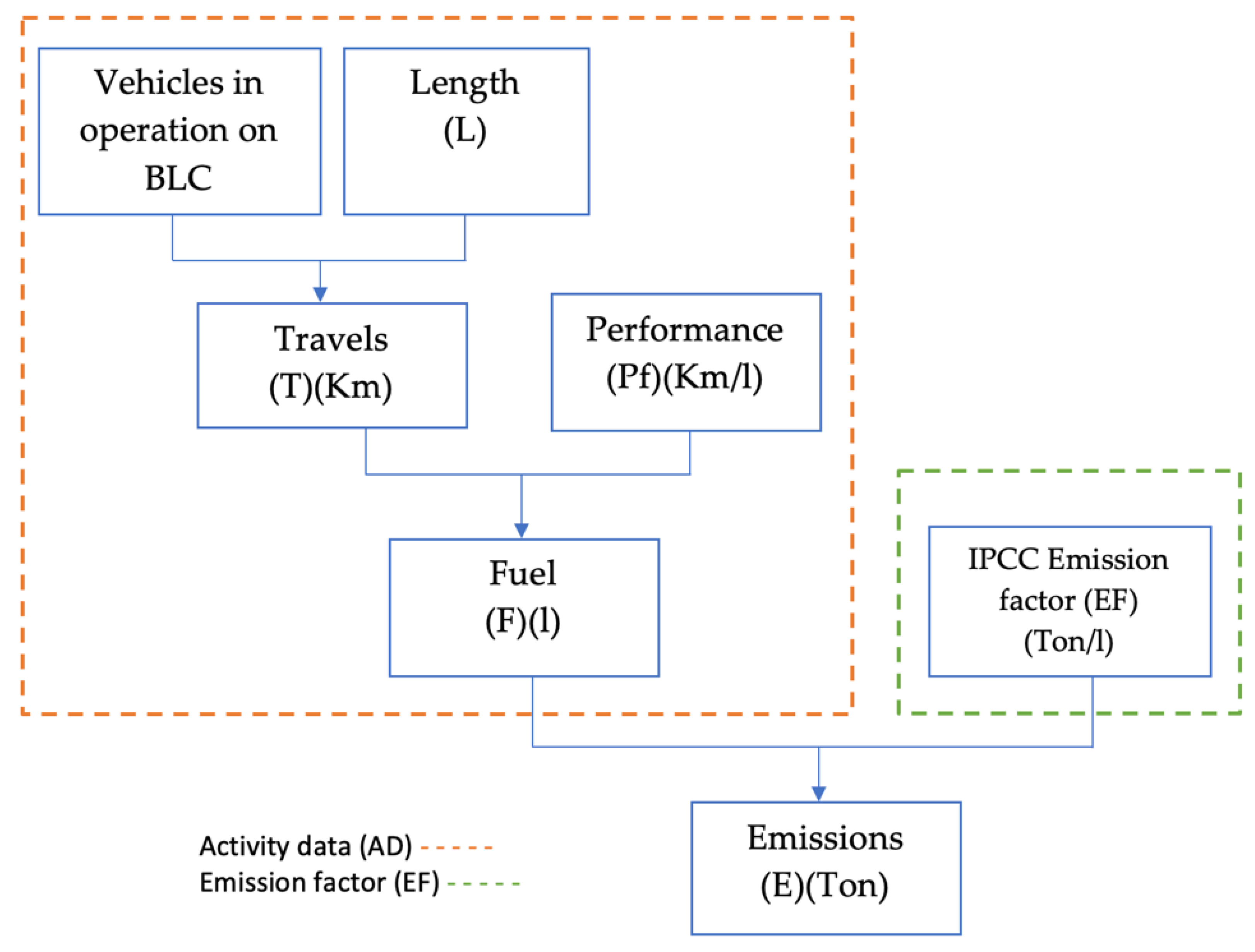
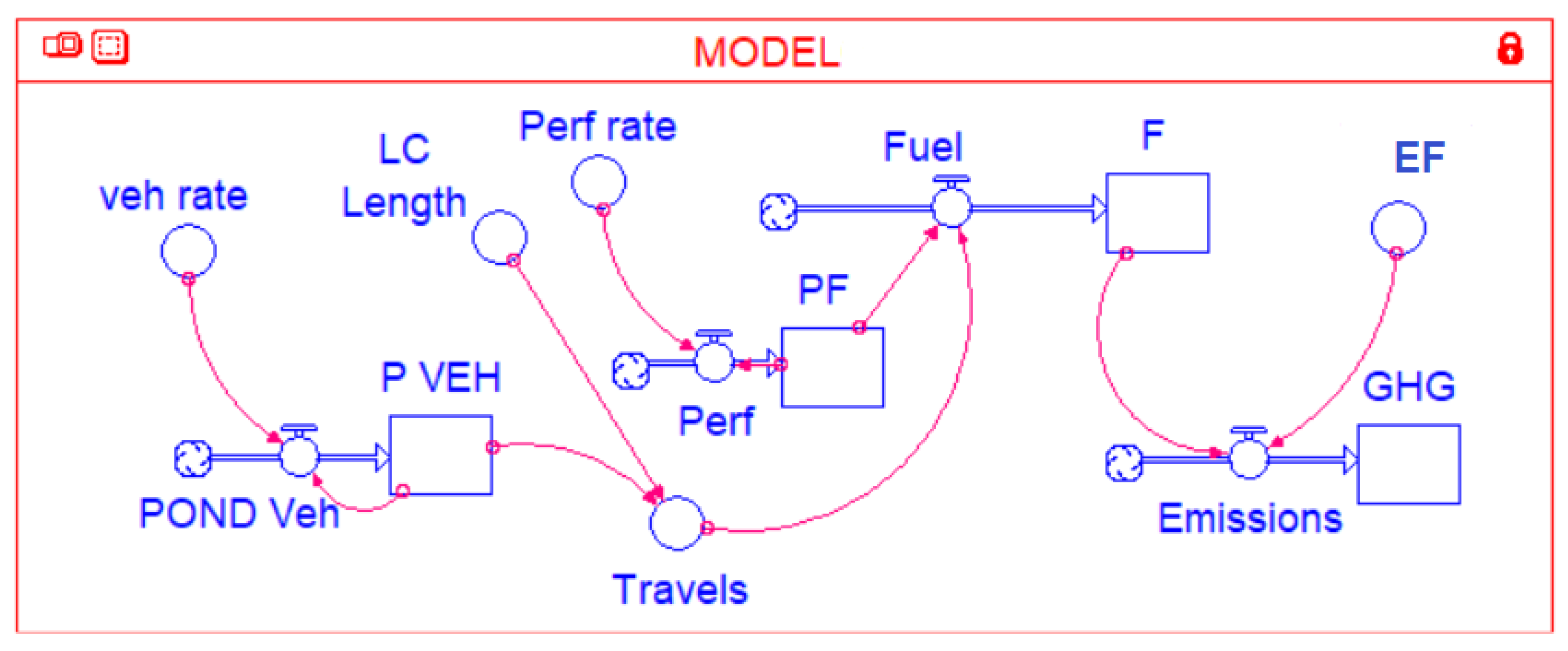
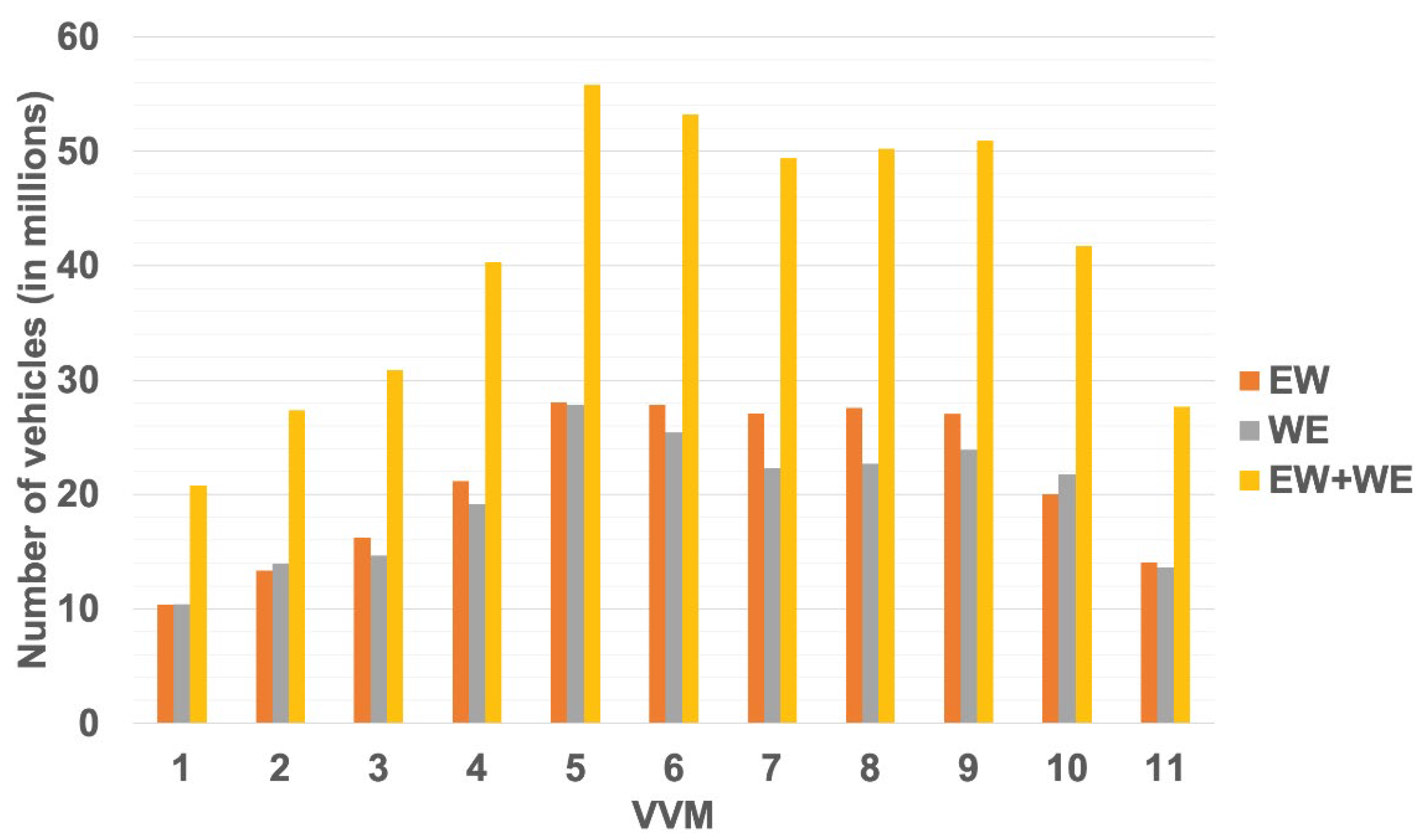
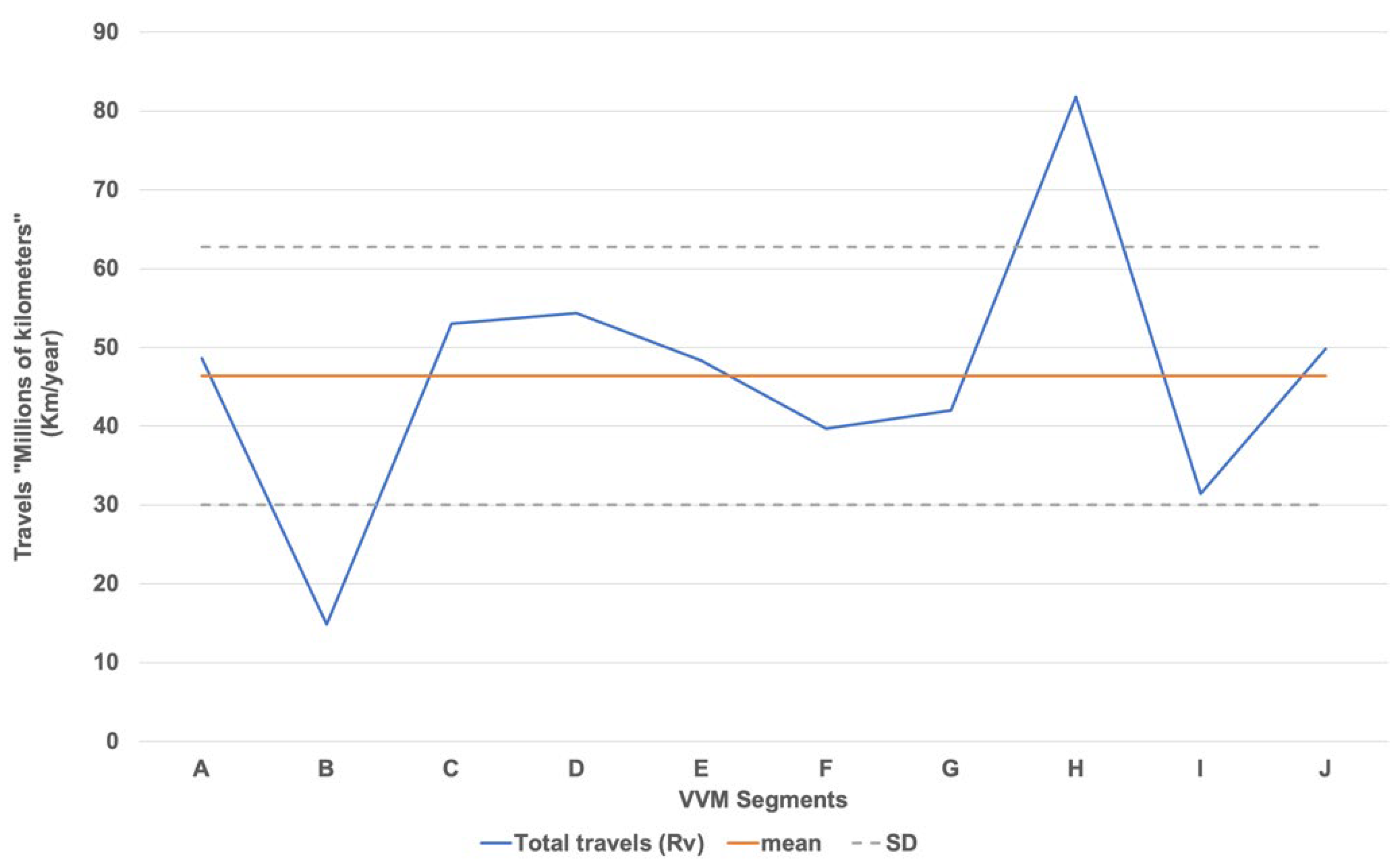
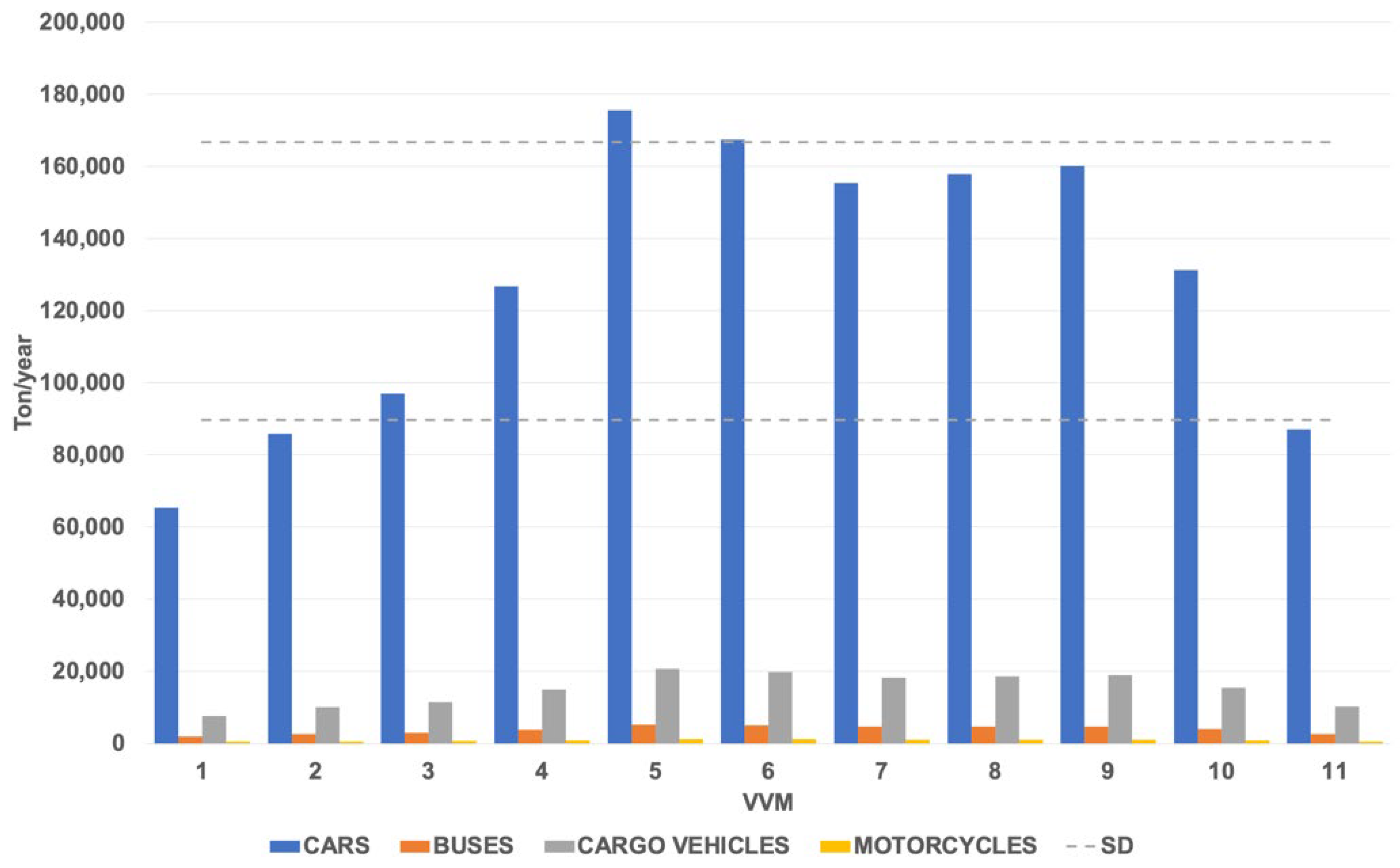
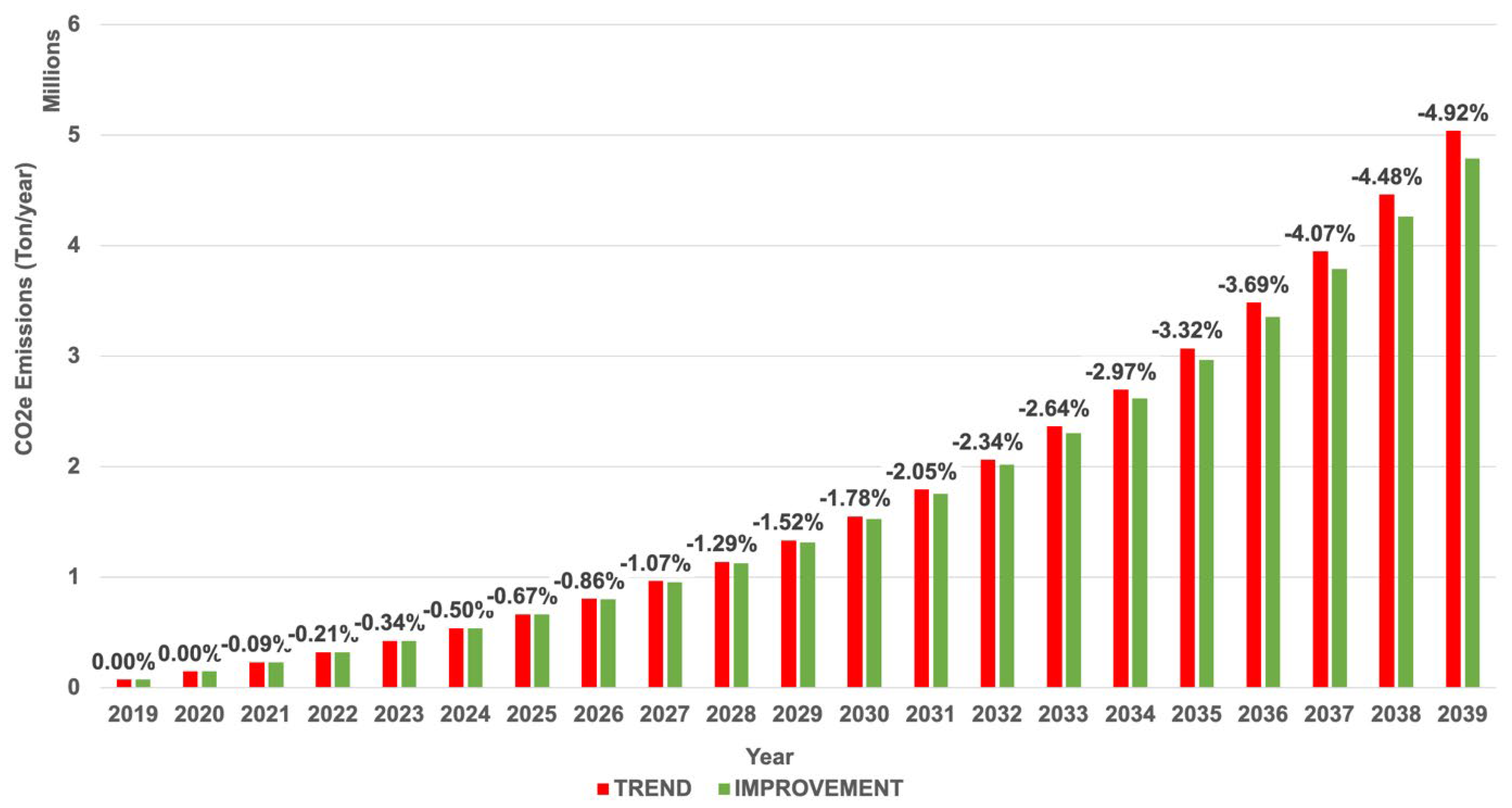
| Dependent Variable | Formula/Data |
|---|---|
| Vehicles in operation on BLC (V) | 40,748,850 |
| Length (L) | L (every segments from A to J) |
| Travels (T) | T = V × L |
| Performance (Pf) | 7.53 Km/L |
| Fuel (F) | F = T/Pf |
| Emissions (E) | E = EF × AD |
| Emissions by Vehicle Type | Travels | Performance | Fuel | Emission Factor * | CO2e Emissions | ||
|---|---|---|---|---|---|---|---|
| Type | % | Units | Km/Year | Km/L | L/Year | ton/L | ton/Year |
| Cars | 94.00 | 38,303,919 | 436,664,678 | 7.821 | 55,832,333 | 0.0022 | 128,152 |
| Buses | 0.91 | 370,815 | 4,227,286 | 3.673 | 1,150,940 | 0.0033 | 3816 |
| Cargo vehicles | 3.91 | 1,593,280 | 18,163,392 | 3.982 | 4,561,374 | 0.0033 | 15,123 |
| Motorcycles | 1.18 | 480,836 | 5,481,535 | 44.000 | 124,580 | 0.0070 | 880 |
| Total | 464,536,891 | 147,971 | |||||
Publisher’s Note: MDPI stays neutral with regard to jurisdictional claims in published maps and institutional affiliations. |
© 2022 by the authors. Licensee MDPI, Basel, Switzerland. This article is an open access article distributed under the terms and conditions of the Creative Commons Attribution (CC BY) license (https://creativecommons.org/licenses/by/4.0/).
Share and Cite
Ibañez-Acevedo, Y.A.; Cruz-Sotelo, S.E.; Flores-Jiménez, D.E.; Santillán-Soto, N.; Santos-Gómez, M.d.l.Á.; Ojeda-Benitez, S. Greenhouse Gas Emission Scenarios and Vehicle Engine Performance in a Main Urban Road in Northwestern Mexico. Appl. Sci. 2022, 12, 12502. https://doi.org/10.3390/app122312502
Ibañez-Acevedo YA, Cruz-Sotelo SE, Flores-Jiménez DE, Santillán-Soto N, Santos-Gómez MdlÁ, Ojeda-Benitez S. Greenhouse Gas Emission Scenarios and Vehicle Engine Performance in a Main Urban Road in Northwestern Mexico. Applied Sciences. 2022; 12(23):12502. https://doi.org/10.3390/app122312502
Chicago/Turabian StyleIbañez-Acevedo, Yidanes Alejandra, Samantha E. Cruz-Sotelo, David E. Flores-Jiménez, Néstor Santillán-Soto, Ma. de los Ángeles Santos-Gómez, and Sara Ojeda-Benitez. 2022. "Greenhouse Gas Emission Scenarios and Vehicle Engine Performance in a Main Urban Road in Northwestern Mexico" Applied Sciences 12, no. 23: 12502. https://doi.org/10.3390/app122312502
APA StyleIbañez-Acevedo, Y. A., Cruz-Sotelo, S. E., Flores-Jiménez, D. E., Santillán-Soto, N., Santos-Gómez, M. d. l. Á., & Ojeda-Benitez, S. (2022). Greenhouse Gas Emission Scenarios and Vehicle Engine Performance in a Main Urban Road in Northwestern Mexico. Applied Sciences, 12(23), 12502. https://doi.org/10.3390/app122312502








